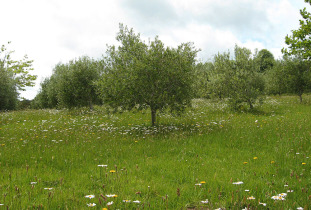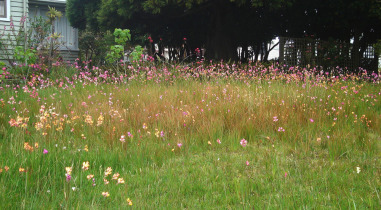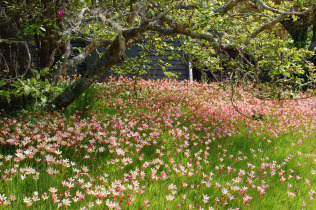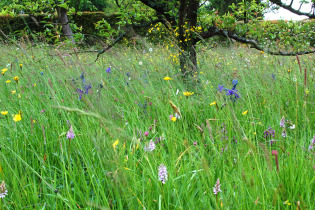A plea for flowers in the long grass
This is the fifth article of a series of short pieces for landscapedesign.co.nz in which I look at current trends and ideas in garden design.

There is a lot of intensively mown grass in New Zealand–road berms, parks and reserves, garden lawns and various types of ‘unused land’–even if we exclude sports pitches. Most of this grass is seen primarily as a maintenance liability and it is responsible for the consumption of a significant amount of fossil fuels, fertiliser and pesticides, the emission of noise, greenhouse gases and other pollution, plus the need to dispose of waste organic material.
But mown grass appears to be indispensable. It is what we expect… a park without mown grass? Heaven forbid! A suburban garden without a lawn? – what would people think? Why is it that we are so committed to the lawn that is mown down to 15 mm and sprayed around the edges as soon as the daisies and dandelions start to flower? Why do we hire armies of peripatetic mowing contractors to drive round at least every two weeks to mow if not fertilise and spray with weedkillers? All so we can have a patch of green concrete.
I will not venture into the possible cultural and psychological reasons for the unfailing popularity of mowing grass! But I will offer some other options–and I don’t mean other plants that look a bit like a traditional lawn but don’t need mowing. In my experience lawn-substitutes like chamomile, Leptinella, Selliera and thyme have never really caught on for two reasons. First, they are expensive to establish compared to sowing grass seed because they have to be densely stocked with small plants and second, although you don’t need to mow them, there is actually quite a lot of skilled maintenance needed – more in fact than for pushing a mower around a grass lawn, because these plants easily become overtaken by weeds, often die out in patches and their vigour and success in any location is quite variable and hard to predict. These species are certainly very good ground covers in the right situation and in combination with other plants, but they are not an economical way of creating a good-looking, hard-wearing circulation surface. If we need lawns for running and walking and lying on there is nothing better than mown grass but it can still include other species which will add to the experience of the walking, running and lying.
So, my argument will focus on how to make grass-based lawns more interesting and better for the ecology, how to make them more diverse, better habitat, and much more attractive. I am not offering an alternative to sports turf, but I am going to suggest that we stop seeding huge areas with a limited range of over-vigorous grass species and them spend every weekend using lots of petrol and pesticide keeping them under control.
In nature, grasslands are the home of an extraordinary range of some of the most popular and colourful plants that have become garden favourites. Species such as Campanula, Echinacea, Rudbeckia, Chrysanthemum, Geranium, Kniphofia, and many others are all grassland plants, adapted to and growing in the natural and semi-natural grasslands of North America, South Africa and Europe. Here in New Zealand the tussock grasslands of upland areas are also often associated with attractive flowering plants such as Bulbinella and Wahlenbergia.
Before the advent of motor mowers and agrichemicals, grass in gardens and parks was cut with shears and scythes and sickles and included a diverse mixture of other plants (called ‘forbs’ in the technical literature). These species were planted in the grass and enjoyed for their flower and foliage which added greatly to the attractiveness of the lawn – the ‘flowery mead’ was one of the highlights of the mediaeval garden.
Many of these species, such as daisy, buttercup, selfheal, violet and clover, remain familiar and common today. Just because they are common we should not underestimate their value, both visually and as food for insects including many important pollinators. These flowers are very well adapted to growing in even quite short cut grass. So, to gain benefit from them today, all we have to do is ease off with the mowing – do it less often and lift the blade height. The other thing to stop is the application of fertiliser, herbicide and pesticide. Poor soil is actually an advantage when it comes to plant diversity in grassland and, obviously, selective herbicide would defeat the object by killing the flowering forbs!

1 A low mowing regime in this olive orchard gives us a simple but lovely meadow with moon daisy and other common grassland species, all good for wildlife.
To share our lawns and grassy places with other plants again, to create meadows where there were only monocultures has great potential for the garden and public parks. It is what designer Arne Maynard calls ‘bejeweling the garden’. A recent visit to Europe showed me how popular this idea has become. The Europeans (and in fact the Americans too) have always been less fanatical about close shaving their lawns and parks and have preferred the luxurious, if not tousled, look over the ‘number 1’ or butch, shaved top. They are now enthusiastically creating ‘floral lawns’ and ‘park meadows’ by planting flowering perennials and bulbs into their lawns and parks and over-seeding with wildflower mixtures.

2 A floral front lawn in Auckland where the grass is a backdrop for a wonderful display of naturalized Ixia and other spring bulbs in October.
There are a number of models or precedents for this biodiverse grassland. The spring bulb field is a familiar one. Here winter and spring bulbs emerge through the dormant grass and are allowed to die down again before the first cut. An extension of this is the early summer meadow where early bulbs can be combined with later flowering species that are summer dormant (in New Zealand these would include for example Freesia, Sparaxis and Ixia).

3 A stunning lawn thick with Sparaxis, Ixia and Tritonia in Auckland.
The grass can then be cut regularly from mid-summer onwards (though not too close) so that it goes through two distinct personalities during the year – a colourful meadow of flowers and grass followed by a mown lawn (this is the regime at Christopher Lloyd’s famous meadow lawn at Great Dixter in the UK. It also echoes the traditional management of rural hay meadows where the sward would be allowed to grow to maximum foliage height, then mown and stacked for hay and grazed for the rest of the growing season.

4 The famous front meadow at Great Dixter. Some of the visiting public have been heard to comment on the ‘neglect’ of mowing! This meadow is in fact mown from midsummer onwards, after the flowers have set seed.
If desired and an objective is minimizing maintenance, the meadow can be simply left and cut at the end of the growing season for the sake of tidiness through the winter. Research is being carried out in the UK to determine which perennials thrive and persist in these conditions, and so can be introduced into rough grass which is only cut once or twice a year. Results so far indicate that many species of Geranium, Persicaria, Alchemilla, and Leucanthemum are perfectly happy growing with coarse grasses. These dense foliage and flower and seed rich environments are very good for invertebrates, lizards and other beneficial wildlife.
So, why not? Is it our anxiety about untidiness? Is it the fact that these plants are not New Zealand natives? Worry about weeds? About what the neighbours will think? Or simply a lack of understanding and the right skills? I hope it is the last of these because understanding and skills can be gained if we want them and the best way to learn is to try it!

Nick has twenty years’ plus experience of landscape architecture professional practice in New Zealand and Britain. Before setting up his own practice he worked on significant landscape projects across the North of England as a Landscape Architect for Arnold Weddle, for Rotherham Metropolitan Council, and as Design Principal for ECUS, the Environmental Consultancy of the University of Sheffield. This work included a number of award winning landscapes of industry, new roads, campuses, urban regeneration and parks. Nick has worked for over 10 years in New Zealand, gaining broad experience of landscape design in the varied natural and cultural landscapes of the South Pacific.
In addition to professional practice, Nick has taught landscape architecture at universities in the UK (Sheffield and Gloucestershire), USA (Cal Poly) and New Zealand (Lincoln and UNITEC) and has a range of publications to his credit including the Planting Design Handbook (now in its revised second edition) and journal articles. He has recently completed a sabbatical period working and studying at the Department of Landscape, University of Sheffield, UK, with a focus on current thinking on ecological approaches to urban design and innovations in planting design for biodiversity, and working with international experts on urban ecology, green roofs and green walls.

